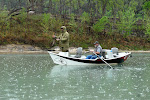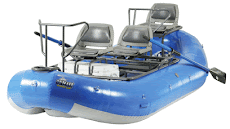Oklahoma Department of Wildlife Conservation (ODWC) stream biologists have discovered the invasive algae Didymo in the Lower Mountain Fork River (LMFR) in Beavers Bend Park in Oklahoma. Didymo can be very destructive to river vegetation and insect populations, thus significantly affecting fish populations. The concern is that fishermen could unwittingly transport Didymo from the LMFR to the Guadalupe (or any other rivers), so I want to alert our members about this risk and inform them on what they can do to prevent transmission of Didymo.
A little background - Didymo (commonly called "rock snot", it appears as a whitish gray blob similar to wet toilet paper) is an algae that attaches to stream rocks and can completely cover the river bottom, thus suffocating vegetation and bugs. Obviously this can be detrimental to trout populations. It was probably transported to the LMFR by way of felt wading boots, gravel guards, wading staffs or any other devices that it could stay alive on while being transported from one stream to another. It has been in some rivers in Arkansas for at least a year. The main concern at this point is that we do not transport Didymo to non affected rivers such as the Guadalupe, the Blue River in Oklahoma, or any other rivers our members fish. What our members can do is thoroughly clean all their equipment immediately after returning from a trip to the LMFR. Further information on Didymo and what can be done to prevent spreading it can be found at the following site.
http://www.tu.org/site/c.kkLRJ7MSKtH/b.3205851/apps/s/content.asp?ct=5935553
ODWC has requested that we please not try to contact them directly. Please ask anyone with questions to call or email me. As additional information becomes available I will pass it on to you.
Thanks Bill,
Friday, May 8, 2009
Sunday, May 3, 2009
River Etiquette
With the increased popularity of fly fishing, the rivers and streams of the the Country are fast becoming the choice for many new anglers. With the increased popularity, stream etiquette is more important than ever. In the old days, it was not all that difficult to elude the one or two anglers, met in a day’s outing. Today, eluding our fellow anglers is an ever-continuing and often insurmountable problem.
The prime rule is…….conduct yourself so as to disturb your fellow angler as little as the prevailing conditions allow. Here are a few additional recommendations from a number of different sources.
1. Respect other anglers’ rights. Don’t crowd another angler or make loud noises when another person is fishing. A good rule of thumb is, stay at least 100’ from the nearest angler. Let me repeat this one….100’. It’s not that far.
2. Approach the water quietly and cautiously. If you come upon another angler on the stream, enter well upstream or downstream. A 100’ comes to mind. Enter the water as quietly as possible. Avoid splashing and disrupting the water.
3. If you come upon another angler while wading in a river or stream leave the water and walk around them well away from the bank. Re-enter the water sufficiently far away from him. 100’ might be good. Pass an angler by giving them as much space as possible without endangering your safety or trespassing on private property. Wade quietly behind them when passing so as not to put the fish down. If at all in question about crowding another angler, just ask them if they feel you are fishing too close. If someone starts crowding you, tell them something like: “You’re getting a little close to me. If you wait a few minutes, I’ll be finished here and you can have it to yourself.” Above all, avoid confrontation.
4. When floating, always float behind the wading angler if possible. Even then warn them you are behind them to avoid getting hit by the back cast. Sometimes in low water conditions you will have to float in front of the angler. If you find yourself in this position, stop and wait, give them a chance to motion you through. If the angler does not see you, let the angler know you are coming through and make sure he/she does not have a fish on. Only paddle when necessary and then don’t splash or smack the paddles on the water. Short soft strokes. Stay as far as possible from the area being fished. Also, apologize, and let him know you had no other choice. Most anglers are very understanding.
On a more personal note, On opening day and most weekend mornings on some rivers, trout fishers are lined up shoulder to shoulder to catch the stocked rainbows. On other river the expectation of silence and solitude, in that setting, getting within one hundred feet of another angler could be considered close quarters. As far as distance goes, use your best judgment. It is different in different rivers at different times. Some fishers prefer silence and solitude to concentrate on their fishing, while others are willing to converse with those around them. Again, use your judgment.
Bill
The prime rule is…….conduct yourself so as to disturb your fellow angler as little as the prevailing conditions allow. Here are a few additional recommendations from a number of different sources.
1. Respect other anglers’ rights. Don’t crowd another angler or make loud noises when another person is fishing. A good rule of thumb is, stay at least 100’ from the nearest angler. Let me repeat this one….100’. It’s not that far.
2. Approach the water quietly and cautiously. If you come upon another angler on the stream, enter well upstream or downstream. A 100’ comes to mind. Enter the water as quietly as possible. Avoid splashing and disrupting the water.
3. If you come upon another angler while wading in a river or stream leave the water and walk around them well away from the bank. Re-enter the water sufficiently far away from him. 100’ might be good. Pass an angler by giving them as much space as possible without endangering your safety or trespassing on private property. Wade quietly behind them when passing so as not to put the fish down. If at all in question about crowding another angler, just ask them if they feel you are fishing too close. If someone starts crowding you, tell them something like: “You’re getting a little close to me. If you wait a few minutes, I’ll be finished here and you can have it to yourself.” Above all, avoid confrontation.
4. When floating, always float behind the wading angler if possible. Even then warn them you are behind them to avoid getting hit by the back cast. Sometimes in low water conditions you will have to float in front of the angler. If you find yourself in this position, stop and wait, give them a chance to motion you through. If the angler does not see you, let the angler know you are coming through and make sure he/she does not have a fish on. Only paddle when necessary and then don’t splash or smack the paddles on the water. Short soft strokes. Stay as far as possible from the area being fished. Also, apologize, and let him know you had no other choice. Most anglers are very understanding.
On a more personal note, On opening day and most weekend mornings on some rivers, trout fishers are lined up shoulder to shoulder to catch the stocked rainbows. On other river the expectation of silence and solitude, in that setting, getting within one hundred feet of another angler could be considered close quarters. As far as distance goes, use your best judgment. It is different in different rivers at different times. Some fishers prefer silence and solitude to concentrate on their fishing, while others are willing to converse with those around them. Again, use your judgment.
Bill
Subscribe to:
Posts (Atom)













